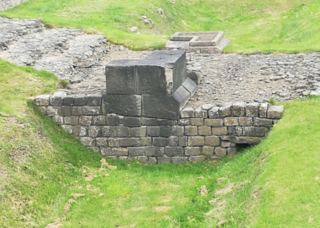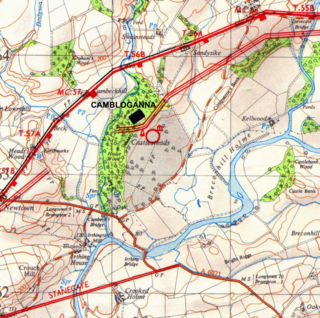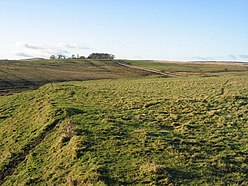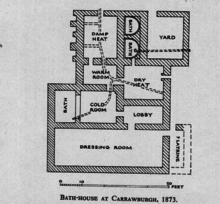
Coventina was a Romano-British goddess of wells and springs. She is known from multiple inscriptions at one site in Northumberland, England, an area surrounding a wellspring near Carrawburgh on Hadrian's Wall. It is possible that other inscriptions, two from Hispania and one from Narbonensis, refer to Coventina, but this is disputed.
In Romano-British culture and Germanic polytheism, the Alaisiagae were a quartet of Celtic and Germanic goddesses deifying victory.

There are many Roman sites in Great Britain that are open to the public. There are also many sites that do not require special access, including Roman roads, and sites that have not been uncovered.

Hadrian's Wall Path is a long-distance footpath in the north of England, which became the 15th National Trail in 2003. It runs for 84 miles (135 km), from Wallsend on the east coast of England to Bowness-on-Solway on the west coast. For most of its length it is close to the remains of Hadrian's Wall, the defensive wall built by the Romans on the northern border of their empire. This is now recognised as part of the "Frontiers of the Roman Empire" World Heritage Site.

Magnis or Magna was a Roman fort near Hadrian's Wall in northern Britain. Its ruins are now known as Carvoran Roman Fort and are located near Carvoran, Northumberland, in northern England. It was built on the Stanegate frontier and Roman road, before the building of Hadrian's Wall.

Ardotalia is a Roman fort in Gamesley, near Glossop in Derbyshire, England.

Cilurnum or Cilurvum was an ancient Roman fort on Hadrian's Wall at Chesters near the village of Walwick, Northumberland. It is also known as Walwick Chesters to distinguish it from Great Chesters fort and Halton Chesters.

Pons Aelius, or Newcastle Roman Fort, was an auxiliary castra and small Roman settlement on Hadrian's Wall in the Roman province of Britannia Inferior, situated on the north bank of the River Tyne close to the centre of present-day Newcastle upon Tyne, and occupied between the 2nd and 4th centuries AD.
Cohors prima Aquitanorum was a Roman auxiliary infantry regiment. It was probably originally raised in Gallia Aquitania in the reign of founder-emperor Augustus after the revolt of the Aquitani was suppressed in 26 BC. Unlike most Gauls, the Aquitani were not Celtic-speaking but spoke Aquitanian, a now extinct non Indo-European language closely related to Basque.

Condercum was a Roman fort on the site of the modern-day Condercum Estate in Benwell, a suburb of Newcastle upon Tyne, England. It was the third fort on Hadrian's Wall, about 6.8 miles east of Rudchester fort and only 2.4 miles west of Pons Aelius fort (Newcastle), and was situated on a hilltop 2 miles (3 km) to the west of the city.

Vindobala was a Roman fort with the modern name, and in the hamlet of, Rudchester, Northumberland. It was the fourth fort on Hadrian's Wall, and situated about 11 kilometres (6.8 mi) to the west of Condercum (Benwell) fort and 7.5 miles east of Halton Chesters fort. The site of the fort is bisected by the B6318 Military Road, which runs along the route of the wall at that point.

Camboglanna was a Roman fort. It was the twelfth fort on Hadrian's Wall counting from the east, between Banna (Birdoswald) almost 7 miles (11 km) to the east and Uxelodunum (Stanwix), 9 miles to the west. It was on a high bluff commanding the Cambeck Valley. It guarded an important approach to the Wall and also watched the east bank of the Cambeck against raiders from the Bewcastle area. The site was drastically levelled in 1791 when the gardens of Castlesteads House were laid over it. The name "Camboglanna" is believed to mean "Crook Bank", or "Bent Valley" because it overlooks a bend in the river Irthing; the name is Brythonic, made of cambo- "curved, bent, crooked" and glanna "steep bank, stream/river side, valley with a stream".

Aballava or Aballaba was a Roman fort on Hadrian's Wall, between Petriana (Stanwix) to the east and Coggabata (Drumburgh) to the west. It is about one and a half miles south of the Solway Firth, and its purpose was to guard the south end of two important Solway fords, the Peat Wath and the Sandwath, which were also to become favourite routes for medieval border raiders.

Hadrian's Wall, is a former defensive fortification of the Roman province of Britannia, begun in AD 122 in the reign of the Emperor Hadrian. Running from Wallsend on the River Tyne in the east to Bowness-on-Solway in the west of what is now northern England, it was a stone wall with large ditches in front of it and behind it that crossed the whole width of the island. Soldiers were garrisoned along the line of the wall in large forts, smaller milecastles, and intervening turrets. In addition to the wall's defensive military role, its gates may have been customs posts.

Bewcastle Roman Fort was built to the north of Hadrian's Wall as an outpost fort possibly intended for scouting and intelligence. The remains of the fort are situated at the village of Bewcastle, Cumbria, 7 miles (11 km) to the north of the Roman fort at Birdoswald, on Hadrian's Wall.
Rudchester Mithraeum is a Roman temple to the Roman god Mithras at Rudchester (Vindobala), an auxiliary fort on Hadrian's Wall, the northern frontier of Roman Britain. The temple was located 137m to the west of the castra. It is not currently visible to visitors to the site.

Milecastle 19 (Matfen Piers) was a milecastle of the Roman Hadrian's Wall. Sited just to the east of the hamlet of Matfen Piers, the milecastle is today covered by the B6318 Military Road. The milecastle is notable for the discovery of an altar by Eric Birley in the 1930s. An inscription on the altar is one of the few dedications to a mother goddess found in Roman Britain, and was made by members of the First Cohort of Varduli from northern Spain. The presence of the Vardulians at this milecastle has led to debate amongst archaeologists over the origins of troops used to garrison the wall. A smaller altar was found at one of the two associated turrets.

Gemellae was a Roman fort and associated camp on the fringe of the Sahara Desert in what is today part of Algeria. It is now an archaeological site, 25 km south and 19 km west of Biskra, and 5 km southwest of the present-day village of M'Lili with which it probably shares an original Berber name. It was connected by military Roman road to Castellum Dimmidi and Capsa.

Milecastle 59 (Old Wall) was a milecastle on Hadrian's Wall (grid reference NY48546174).
Milecastle 65 (Tarraby) was a milecastle on Hadrian's Wall (grid reference NY40855793).























